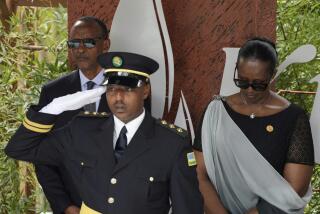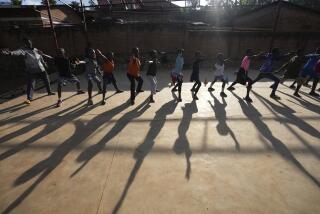U.N. Chief Visits Survivors at Site of ’94 Rwandan Massacre
- Share via
KIGALI, Rwanda — In one of many difficult moments during his visit to Rwanda, U.N. Secretary-General Kofi Annan was taken Friday to a massacre site where a genocide survivor told how he and fellow Tutsis held off Hutu killers for eight days with rocks, machetes and sticks--while hoping for rescue from U.N. peacekeepers who never came.
“We waited for the help of the United Nations and Kofi Annan,” said Charles Butera, one of 100 genocide survivors waiting for Annan in Mwulire, a settlement 30 miles southeast of the capital, Kigali.
Annan and his wife, Nane, walked through a hangar made of corrugated iron sheeting filled with the bones of an estimated 3,000 genocide victims, divided neatly into piles of skulls, ribs and femurs. They placed a wreath on stacks of crumbling bones.
“I and the whole international community share your pain, share your tragedy,” a somber Annan told Butera and the other survivors.
During his two-day visit, he was admonished by Rwanda’s foreign minister, roasted by national assembly politicians, boycotted by the country’s rulers and snubbed by survivors of the 1994 genocide, in which more than 800,000 people died, most of them ethnic Tutsis.
Three months before the bloodletting started April 7, Annan’s office was warned of a plan by Hutu extremists to exterminate the country’s Tutsis. But a U.N. peacekeeping force in Kigali was ordered not to intervene.
Annan has often complained that U.N. member countries were unwilling to deploy peacekeepers to Rwanda, despite many pleas.
Before Annan departed Friday for Uganda, he and Rwandan President Pasteur Bizimungu insisted at a news conference that they were friends.
A senior U.N. diplomat later told reporters that a private meeting between Annan and government leaders had cleared the air.
“By the end, the mood had brightened and was cordial,” the diplomat said, adding that the Rwandans had explained that their problem “was with the organization, not the man.”
More to Read
Sign up for Essential California
The most important California stories and recommendations in your inbox every morning.
You may occasionally receive promotional content from the Los Angeles Times.










